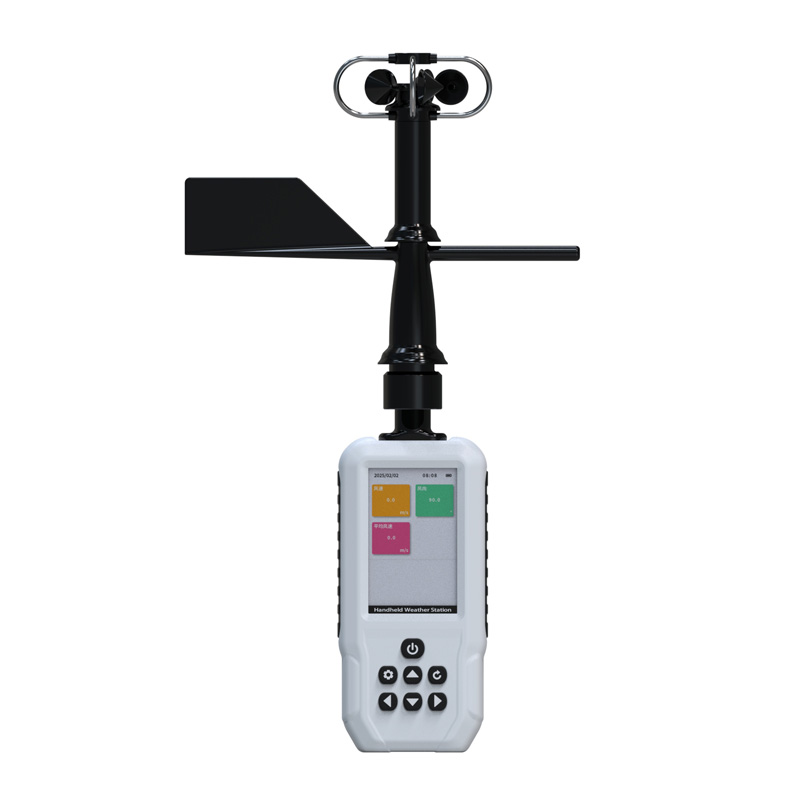Tianqiong Sensor IOT Technology Co., Ltd
Sales Manager:Ms. Emily Wang
Cel,Whatsapp,Wechat:+86 15898932201
Email:info@fengtutec.com
Add:No. 155 Optoelectronic Industry Accelerator, Gaoxin District, Weifang, Shandong, China

Sales Manager:Ms. Emily Wang
Cel,Whatsapp,Wechat:+86 15898932201
Email:info@fengtutec.com
Add:No. 155 Optoelectronic Industry Accelerator, Gaoxin District, Weifang, Shandong, China
time:2025-11-24 10:32:16 source:Weather Station viewed:30 time
Handheld Anemometer is an instrument used to measure air flow speed and direction. It features automatic monitoring, real-time display, and over-limit alarm functions, and is widely used in meteorology, environmental monitoring, and industrial safety.
Handheld Anemometer is an instrument used to measure air flow speed and direction, primarily for obtaining instantaneous wind speed and direction data. The device comes with an LCD display and data communication functions, and features advanced technology, high measurement accuracy, and low power consumption. The system has functions such as automatic monitoring, real-time display, over-limit alarm, and control, and is suitable for various types of cranes such as gantry cranes, bridge cranes, tower cranes, and overhead cranes, as well as ports, docks, and cableways. It is widely used in meteorology, environmental monitoring, aerospace, and agriculture.
The working principle of Handheld Anemometer is based on different sensing technologies. Common types include mechanical anemometers and ultrasonic anemometers. Mechanical anemometers typically use a wind cup or propeller structure, calculating wind speed by measuring the rotation speed of the wind cup or propeller. Wind direction measurement often uses a wind vane combined with a potentiometer or encoder. Ultrasonic anemometers calculate wind speed and direction by measuring the difference in the speed of ultrasonic waves propagating in the air. The integrated microprocessor inside the device processes the sensor signals, converting physical quantities into digital signals, displaying the measurement results directly on the LCD screen, and simultaneously transmitting them to the monitoring system through the data communication interface.
In the field of industrial safety, Handheld Anemometer plays a vital role. In port loading and unloading operations, large gantry cranes and bridge cranes are highly sensitive to wind loads. When the wind speed exceeds the safety threshold, Handheld Anemometer will issue an alarm signal, prompting operators to take wind protection measures. On construction sites, tower cranes need to monitor wind speed in real time to ensure operation within a safe wind speed range. In cableway operations, wind speed monitoring is a crucial aspect of ensuring operational safety. In these application scenarios, the reliability and real-time performance of the equipment are critical, directly related to the safety of personnel and equipment.
Meteorological and environmental monitoring is another important application area of Handheld Anemometer. Meteorological observation stations use Handheld Anemometer to collect ground wind field data, providing basic information for weather forecasting. Environmental monitoring departments use it to assess atmospheric diffusion conditions and analyze pollutant transport paths. In agriculture, Handheld Anemometer is used to monitor microclimates in the field, providing reference for agricultural activities such as irrigation and spraying. In the aerospace field, the Handheld Anemometer system is deployed at airports to provide real-time wind field information for safe takeoffs and landings. These applications place high demands on the measurement accuracy and stability of the equipment.
The technical characteristics of the Handheld Anemometer system are significant. Its low-power design makes it suitable for solar-powered outdoor monitoring stations, enabling long-term continuous monitoring. High-precision sensors, coupled with temperature compensation algorithms, ensure accurate data acquisition under various environmental conditions. The automatic monitoring function enables unattended operation, and the over-limit alarm function provides timely alerts for abnormal situations. The data communication interface supports wired or wireless transmission methods, facilitating integration into various monitoring systems. The LCD screen provides convenient local data reading while retaining the ability for remote data transmission.
With technological advancements, the performance of the Handheld Anemometer system continues to improve. New products maintain basic measurement functions while enhancing data processing and communication capabilities. Some high-end models integrate data logging functions, allowing for the storage of long-term monitoring data. The low-power design further extends the equipment's operating time in the field. Features such as lightning protection and corrosion resistance improve the equipment's reliability in harsh environments. In the future, with the development of IoT technology, the Handheld Anemometer system will be better integrated into smart city and intelligent industrial systems, providing more comprehensive solutions for wind speed and direction monitoring needs in various industries.

Micrometeorology is an important branch of meteorology that studies the physical processes and phenomena in the near-surface atmosphere, typically within a range of a few meters to tens of meters above the Earth's surface. Unlike traditional meteorology that focuses on large-scale weather patter...
Traditional meteorological monitoring often relies on large, fixed national-level weather observation stations. While these stations provide extremely accurate data, they also suffer from high construction costs, low density, and limited coverage. With social development, our demand for meteorologic...
TianQiong is an enterprise specializing in meteorological and environmental monitoring, as well as application solutions for the water conservancy industry and related sectors. The company is dedicated to the research, development, production, and sales of various advanced environmental monitoring e...
A farmland weather station is a specialized meteorological monitoring device designed specifically for agricultural production. Its core function is to collect, analyze, and transmit meteorological data in real time, providing a scientific basis for agricultural activities. The hardware includes var...